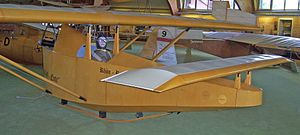avia.wikisort.org - Glider
The Ente (German: duck) was the world's first full-sized rocket-powered aircraft. It was designed by Alexander Lippisch as a sailplane and first flown under power on June 11, 1928, piloted by Fritz Stamer as part of the Opel-RAK rocket program led by Fritz von Opel and Max Valier.[1]
This article needs additional citations for verification. (August 2012) |
| Ente | |
|---|---|
 | |
| RRG Raketen-Ente | |
| Role | Experimental glider |
| National origin | Germany |
| Manufacturer | Alexander Lippisch and Opel-RAK |
| Designer | Alexander Lippisch (glider); Fritz von Opel, Max Valier, Friedrich Sander (rocket propulsion) |
| Number built | 1 |
During the late 1920s von Opel had made a variety of demonstrations involving rocket-powered vehicles for the Opel company. He was assisted by the pyrotechnics manufacturer Friedrich Sander and the rocketry advocate Max Valier. In March 1928 the three men visited the Wasserkuppe, a mountain which had become the center of German gliding to investigate the possibility of fitting rockets to an aircraft. There they encountered some of Lippisch's revolutionary gliders, which because of their tail-less designs seemed suitable for adapting to rocket propulsion. Lippisch was able to demonstrate how models of his aircraft would fly with small rockets installed in them. In June von Opel, Sander, and Valier returned and bought one of his aircraft, the Ente, a canard design.
Two black powder rockets were installed, to be electrically fired by a switch in the cockpit. A counterweight system was also devised and placed under the cockpit floor which would automatically adjust the aircraft's center of gravity as the fuel of the rockets was consumed. The rockets were intended to be fired one after the other, to provide continuous thrust for as long as possible, and each had a burn time of around 30 seconds. Fritz Stamer, who had long been a test pilot for Lippisch's designs was selected to fly the aircraft. After one false start, the aircraft took off and flew a 1,500 metre (4,900 ft) circuit of the Wasserkuppe's landing strip.
On the second flight, the team decided to try firing both rockets together for increased thrust over a shorter period. However, rather than burning properly one of the rockets exploded, punching holes in both wings and setting the aircraft alight. Stamer was nevertheless able to bring it down from a height of around 20 metres (65 ft) before hastily abandoning the Ente, which was burned beyond any hope of repair.
The Opel RAK.1 was developed as the successor to the "Ente", and was demonstrated successfully to the public in September 1929 with Fritz von Opel as pilot.
Specifications (RRG Raketen-Ente)

Data from [2]
General characteristics
- Crew: 1
- Length: 4.31 m (14 ft 2 in)
- Wingspan: 11.94 m (39 ft 2 in)
- Wing area: 20.3 m2 (219 sq ft)
- Aspect ratio: 7
- Powerplant: 2 × Sander black powder rockets, 0.1962 kN (44.1 lbf) thrust each
Performance
- Range: 1.5 km (0.93 mi, 0.81 nmi)
References
- Ford, Roger (2013). Germany's Secret Weapons of World War II. London, United Kingdom: Amber Books. p. 224. ISBN 9781909160569.
- "RRG-Raketen Ente" (in German). Germany: www.segelflugmuseum.de. Archived from the original on 30 January 2018. Retrieved 17 August 2012.
На других языках
[de] Lippisch-Ente
Die Ente war eine von vielen revolutionären Konstruktionen von Alexander Lippisch. Das ursprünglich als Segelflugzeug gebaute Flugzeug in Entenflügler-Bauweise ging am 11. Juni 1928 mit dem ersten bemannten Raketenflug in die Luftfahrtgeschichte ein. Da die Konstruktion ohne ein konventionelles Leitwerk am Heck auskam, eignete sich die Ente besonders für Versuche mit einem Raketenantrieb.- [en] Lippisch Ente
[fr] Lippisch Ente
Le Lippisch Ente (de l'allemand Ente, canard) est le premier avion fusée au monde. Dessiné par Alexander Lippisch comme planeur, il a effectué son premier vol motorisé le 11 juin 1928, piloté par Fritz Stamer[1].[it] Lippisch Ente
L'Ente (anatra in lingua tedesca) fu una costruzione aeronautica di Alexander Lippisch. Era un veleggiatore costruito con ala tipo canard esempio del pionierismo aeronautico: il primo velivolo con propulsione a razzo. Fu anche il primo a non avere un timone di coda convenzionale, non adatto per tale esperimento.Другой контент может иметь иную лицензию. Перед использованием материалов сайта WikiSort.org внимательно изучите правила лицензирования конкретных элементов наполнения сайта.
WikiSort.org - проект по пересортировке и дополнению контента Википедии